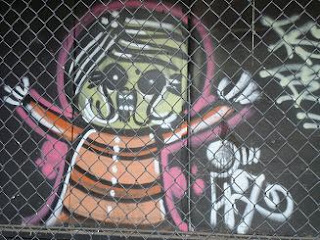 Some people get high on airplane glue, on laundry detergent- complicated stuff. My satori is this: the zen experience of spreading butter. You can look. The knife disappears. The bread disappears. The butter disappears. What remains is the repeated gesture of the hand… a movement. And space. It is emptiness.
Some people get high on airplane glue, on laundry detergent- complicated stuff. My satori is this: the zen experience of spreading butter. You can look. The knife disappears. The bread disappears. The butter disappears. What remains is the repeated gesture of the hand… a movement. And space. It is emptiness.-Gorodish (Richard Bohringer)
DIVA (1982)
___________________
In the middle of Gorodish’s blue loft is a giant jigsaw puzzle derived from Hokusai’s The Great Wave. The surrealism of Jean-Jacques Beineix’s movie masterpiece became apparent when I realized that the mounds of jigsaw pieces for the king-bed sized puzzle would never fit in the notebook sized box at Gorodish’s feet.
Puzzles have long been one of my own satori: a form of meditation, creativity, and path to enlightenment. Once the puzzle is completed, you destroy and restore it to its original chaos in a box.
Like a pre-determined, modernized sand mandala, jigsaw puzzles take shape in order to be destroyed.
~~~~~~~~~~~~~~~~~~~~~~~~~
Consider our world of cameras. How does the act of recording and immediately revisiting static moments take us away from being eternally Present? How does the study of non-attachment and photography collide? How often do we, in our everyday life, photograph mandalas of sand: relationships, dogmas, art, words?

~~~~~~~~~~~~~~~~~~~
In college, artist friends turned an old building scheduled for demolition into a work of temporary landscape art. They brought the outside inside. They hung tree branch mobiles in the halls. They turned found-items from the attic into sculptures. They encouraged brave students on a well-behaved campus to scribble permanent marker ideas on crumbling plaster. The building became a haven of risk and rebelliousness. Knowing full well that whatever beauty, décor and drama we brought to the structure would be destroyed by the wrecking ball, we blossomed during the doomed building's swan song.
Though I remember the picture and words I drew, I don’t have the need to repeat them here. It was a cathartic expression of non-attachment and non-permanence.
Occasionally I wallow in the glow of canonized art on museum walls and relax into the shadows of architectural enlightenment. Nevertheless, I developed an undeniable thirst for the un-recordable, a fascination with art that invites destruction, whether the walls of rotting buildings or private, non-recorded concerts.
While I attempt to digest the complexities of the Situationists and satori, in honor of bypassing my own diva-hood, I write on digital walls as a personal practice of non-attachment.
_____________________________
Words of the Diva (Wilhemina Wiggen Fernandez) at the press conference regardi
....
Journalist: So you are against making art a business?
Diva: Not at all, but business should adapt to art, not the other way around.







1 comment:
I've always been a performer of some description, starting with synchronised swimming as a little girl, through to theatre and finally belly dancing.
And I agree - there's no performance without an audience.
Post a Comment